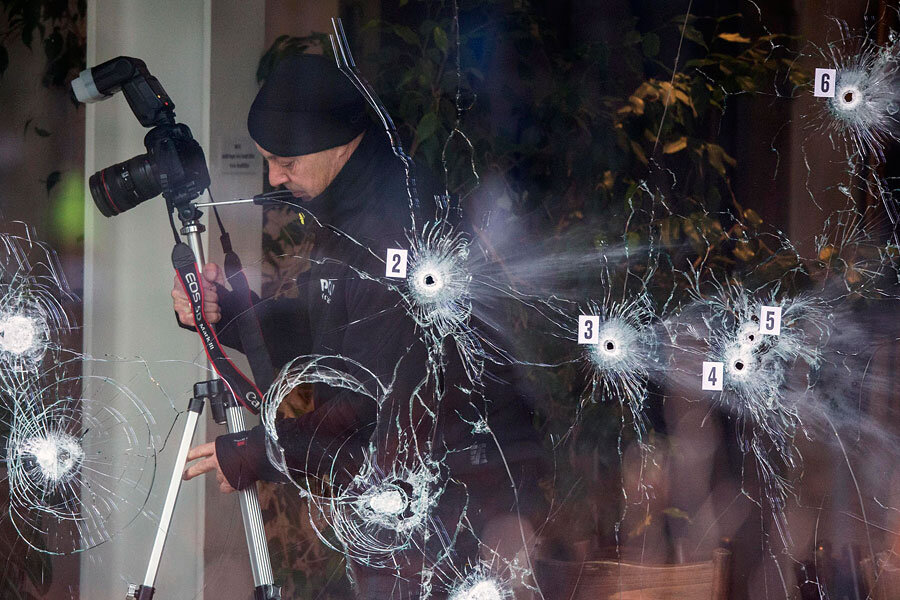Copenhagen attacks: Why an eight-year-old cartoon continues to inflame
Loading...
How long does it take for the wrath of a violent extremist to dissipate?
Saturday's shooting spree in Copenhagen, which killed two civilians and wounded five police officers, began at a free-speech event attended by Swedish artist Lars Vilks, who eight years ago drew a cartoon depicting the Prophet Mohammed as a dog.
The man allegedly behind the attacks was killed in a shootout with police on Sunday morning. Officials have identified, but did not name, him, saying only that he was a 22 years old, a native of Denmark, and had a history of gang-related violence.
That means he would have been just 14 when Vilks published his infamous cartoon. Zealotry, it seems, has a keen memory.
This means that those who happen to offend zealots may be in for a decade or more of grudge-holding. Dr. Vilks knows this all too well: since his 2007 cartoon appeared in the Swedish daily Nerikes Allehanda, he has been subject to numerous death threats, including a $100,000 price on his head issued by the head of al-Qaeda in Iraq. He says that he now keeps an ax at his bedside.
Mr. Vilks was one of the main speakers at Saturday's panel discussion, titled "Art, blasphemy and freedom of expression." He was whisked away by his bodyguards as the shooting began, and was unharmed.
Vilks, 68, later told The Associated Press he believed he was the intended target of the shooting.
"What other motive could there be? It's possible it was inspired by Charlie Hebdo," he said, referring to the Jan. 7 attack by Islamic extremists on the French newspaper.
Vilks is not alone in facing threats. “In nearly half of the world’s countries, journalists and bloggers constantly face censorship in the name of religions, prophets or God,” according to a study by Reporters Without Borders. “If an article involving religion is deemed to be ‘insulting’ or a violation of ‘moral standards,’ the consequences can be dramatic for the author. In countries where laws are so severe that they may even include the death penalty, news and information providers have had to censor themselves for years.”
Using Author Salman Rushdie’s decade in hiding following the publication of “The Satanic Verses” in 1988 as a rule of thumb, Vilkes’ eight years as a target for his political cartoon’s publication my help to build a data arc of an offense’s half-life.
Mr. Rushdie lived in hiding for over a decade under the alias "Joseph Anton" (after Anton Chekov) according to an interview with Der Spiegel in 2012, after Iran's Ayatollah Khomeini issued a fatwa calling for the author's death.
"Religion, a mediaeval form of unreason, when combined with modern weaponry becomes a real threat to our freedoms. This religious totalitarianism has caused a deadly mutation in the heart of Islam and we see the tragic consequences in Paris today,” Rushdie said in a statement sent to The Christian Science Monitor after the attacks in Paris.
“I stand with Charlie Hebdo, as we all must, to defend the art of satire, which has always been a force for liberty and against tyranny, dishonesty and stupidity. “Respect for religion” has become a code phrase meaning “fear of religion.” Religions, like all other ideas, deserve criticism, satire, and, yes, our fearless disrespect."
The Vilks Committee is committee is organized annually, on the anniversary of Salman Rushdie’s fatwa.
In a phone interview, Brigham Young University humanities professor Kerry Soper, who specializes in the history of comedy and satire in various media saif that he would caution any cartoonist considering this kind of lampoon, "This kind of satire is so volatile in nature that it's almost radioactive."
"It' such a complicated process to do political satire," adds Dr. Soper, who published a book on political cartoonist Gary Trudeau. "You have distortion, exaggeration mixed with the real politics and news and that is a recipe for disaster because it's so volatile."
Soper says that political cartoonists today are particularly vulnerable to becoming perpetual targets by extremists, "When you factor-in the cultural divide between radical Islam and the cartoonists it's nothing but dangerous."
Heidi Brooks a professor of Religious studies at Iona College in New Rochelle, New York says in a phone interview, "This is not just Islamic in nature. It's regional. It harkens back to Bedouin tribal practices that the Prophet Mohammed tried to end. The practice was that if your face is blackened you must continue to retaliate until that shame or guilt is removed."
Brooks adds, "There are going to be some people who subscribe to that tribal methodology rather than the Koranic version and if they never feel the blackening of their people has been removed they will retaliate forever. They will never stop because they feel that shame has not been taken away."






